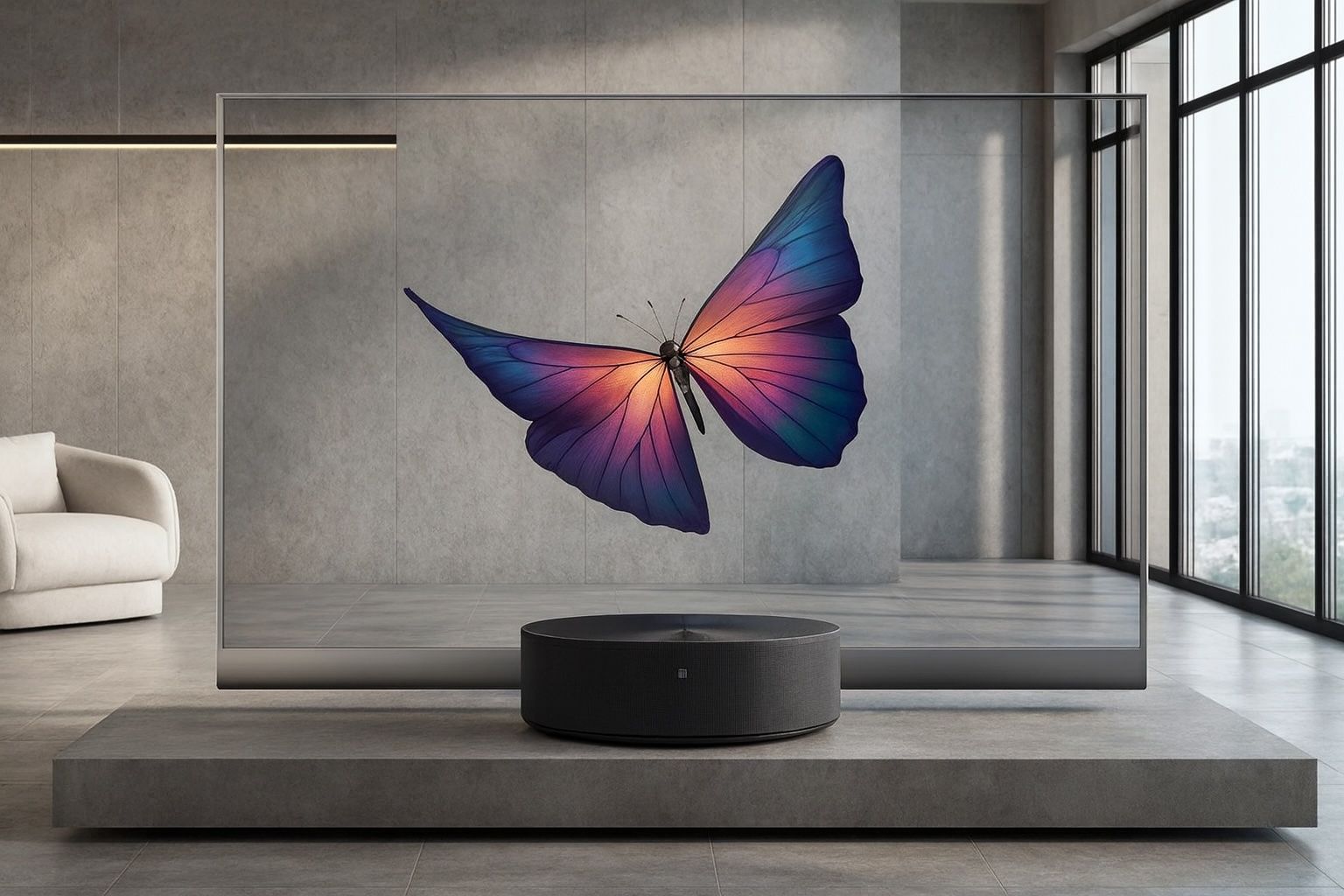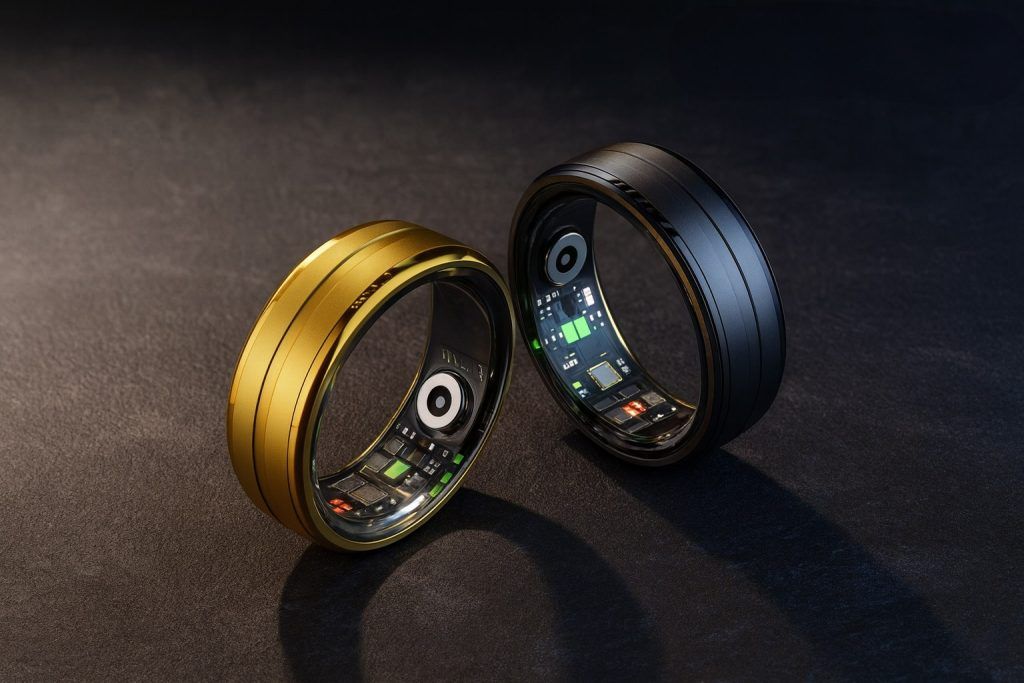- LG SIGNATURE OLED T is a 77-inch 4K transparent OLED TV unveiled at CES and released in late 2024, with wireless 4K/120 Hz video via a Zero Connect box and about 40% transparency in see-through mode.
- Xiaomi Mi TV LUX Transparent Edition is a 55-inch transparent OLED released in August 2020 with 1080p resolution, 120 Hz, 1 ms response, 93% DCI-P3, and electronics housed in the base (no opaque option).
- Samsung revealed transparent MicroLED prototypes around 50–55 inches at CES 2024 First Look, featuring frameless, modular panels with two‑sided visibility and very high brightness, but no confirmed release date.
- LG Display and Panasonic jointly offer a 55-inch transparent OLED module (1080p, about 38% transparency) with an embedded dimming unit for Black Mode, targeting commercial signage.
- TCL CSOT showcased an 8.42-inch transparent microLED prototype at Display Week 2025 delivering 5,000 nits brightness and 0.02 mm pixel pitch, signaling potential small-format AR or HUD use.
- Korea’s KIMM demonstrated a 100-inch Nano Transparent Screen prototype that could be produced at a fraction of OLED cost, signaling a cheaper future option.
- LG’s OLED T launched in the US in late 2024 and Europe in spring 2025 at about €50,000, with US price around $60,000, emphasizing luxury placement and limited availability.
- Transparent TVs face brightness and contrast limitations due to their see-through nature, with LG’s Curtain Mode providing a motorized opaque screen to boost blacks when needed.
- In retail and museums, transparent displays overlay digital content on real objects, such as LG 55-inch panels used in subway windows in Beijing and Shenzhen for maps and news.
- Industry outlook for 2026 expects more brands and larger or higher-resolution transparent screens, potential touch integration, and gradual price rationalization as panel yields improve.
Imagine a TV that disappears into your décor or a shop window that doubles as a screen – welcome to the era of transparent TVs. Once a sci-fi fantasy, see-through televisions are now a reality in 2025, with several brands launching transparent displays for both home use and commercial showcases. In this report, we compare the latest transparent OLED and LED TVs – from luxury living room centerpieces to cutting-edge retail displays – and peek at the futuristic models expected in 2026. We’ll cover how LG, Samsung, Xiaomi, TCL, and others are pushing this tech, including key specs (resolution, panel tech, brightness, transparency levels, audio), unique design features, use cases (from luxury homes to smart retail and museums), pricing, and availability. Let’s see which transparent screens are turning heads and what’s coming next in this “invisible” TV revolution.
Transparent TVs: From Sci‑Fi Concept to Reality
Transparent display technology has rapidly evolved from prototype demos to real products. A transparent TV uses a see-through screen – you can literally see objects behind it when it’s off or showing minimal content. Unlike conventional TVs, these have no opaque back; they’re often made with OLED (organic LED) or the latest microLED panels that emit light independently, requiring no backlight (unlike LCD). This allows for a clear glass-like screen where images appear to float in mid-air [1]. The effect is akin to a hologram and has wowed viewers at recent tech shows.
However, transparent TVs also face limitations. Because there’s no solid backing, black tones are transparent, so contrast and brightness suffer unless the display is in a specialized mode or environment. Early transparent OLEDs tend to be less bright and vivid than normal TVs [2] [3], meaning they perform best in dim lighting or with a backing to enhance contrast. Despite these challenges, industry players have invested years into improving the tech. In fact, LG and others have been refining transparent OLEDs for over five years, addressing brightness and color limitations [4]. By 2024–2025, those efforts paid off with the first large transparent TVs you can actually buy (if you have deep pockets).
Beyond the cool factor, use cases for transparent screens are compelling. In a living room, a transparent TV can vanish into the space – no more big black rectangle on the wall. It can display digital art or information while still letting you see the view or décor behind it. For retail and museums, transparent displays let you overlay digital content on real objects: imagine a store window that plays product videos over the merchandise, or a museum case that projects informational graphics over an artifact. This is already happening – for example, LG supplied 55-inch transparent OLED panels for subway train windows in Beijing and Shenzhen, China, so commuters see real-time maps and news on the glass while still looking outside [5]. Smart retail trials have used see-through screens on vending machines and cooler doors, advertising products while showing the actual items behind the glass. The potential is huge wherever blending digital info with the real world is useful.
Now let’s dive into the leading transparent TV models of 2025 and what to expect in 2026, brand by brand.
LG: Leading the Pack with Transparent OLED TVs
LG Electronics has taken a clear lead in the transparent TV arena with its LG SIGNATURE OLED T – a 77-inch transparent OLED TV that was unveiled at CES and released in late 2024 [6] [7]. This glossy giant (the world’s first consumer 4K transparent OLED TV) is a showcase of LG’s OLED prowess and design ambition. It’s also wireless in terms of video input: the OLED T uses a separate Zero Connect box that beams 4K 120Hz video and audio to the screen without any cables [8] [9]. Aside from a power cord, you can place the glass-panel TV anywhere – even in the middle of a room – with no clutter, a big plus for stylish interiors.
[10] [11]LG’s 77-inch transparent OLED T can toggle between see-through mode and an opaque “black” mode for better contrast when watching movies. Early reviewers noted the transparent image looks washed-out in bright scenes, but a motorized opaque screen rolls down to instantly make it look like a regular OLED with rich blacks – a “secret weapon” that vastly improves picture quality [12] [13].
Technical highlights: The LG OLED T features a 77″ 4K Transparent OLED panel (about ~40% transparent when in see-through mode) and supports up to 120 Hz refresh rate for smooth motion [14]. It’s powered by LG’s latest Alpha 11 AI processor, enabling 4K upscaling and even virtual 11.1.2 surround sound processing [15]. In fact, the TV has built-in 4.2 channel speakers and supports Dolby Atmos for an immersive audio experience [16] [17] – quite a feat given the display’s slim, glassy form. It also supports Dolby Vision HDR, NVIDIA G-Sync and AMD FreeSync for gaming, and LG’s full webOS smart TV platform [18] [19], so it’s as fully featured as any high-end TV. The panel can deliver typical OLED excellent color, though peak brightness is limited (on the order of a few hundred nits) due to the transparent design. LG mitigates this with a feature called “Curtain Mode” – at the push of a button, a motorized opaque curtain (contrast screen) rises behind the transparent panel, turning it into a conventional black-backed OLED for “brilliant picture when you want to watch” [20] [21]. When you’re done, retract it and the screen becomes see-through again, blending into your space. This addresses the contrast issue and essentially gives you two modes: Transparency Mode for that holographic effect (great for art displays or wow-factor demos), and Black Mode for everyday TV viewing with full contrast [22].
LG has also included unique always-on displays and UI tricks for the OLED T. A mode called “T-Objet” turns the idle transparent screen into a digital canvas for artwork, nature scenes, or photos, floating in mid-air [23] [24]. There’s also a “T-Bar” info ticker – a translucent bar along the bottom that can show news, weather, sports scores, or smart home info without blocking the main view [25] [26]. And “T-Home” is a futuristic home screen interface with 3D icons hovering on your transparent menu [27]. All of this cements the OLED T as not just a TV but a high-tech design statement.
Design and use cases: The LG OLED T is undeniably aimed at the ultra-premium market – early adopters, luxury homes, art galleries, corporate lobbies, etc. The display is mounted on a sleek stand with an integrated shelf, and optional add-on side shelves let it double as a piece of furniture or room divider [28]. In a living room, you could position it in front of a window or in the center of a room, and when off (or in transparent mode) it’s “like a window,” virtually invisible [29]. LG’s president of the LG Entertainment Solutions division, Park Hyoung-sei, emphasized that this TV offers “a distinctive, multi-faceted viewing experience and unprecedented spatial flexibility”, transforming how screens integrate with living spaces [30]. In other words, no more big black rectangle dominating the décor – it blends with the environment until you want it to stand out.
At $60,000 a unit, the OLED T is priced for early adopters and luxury buyers [31] [32]. It launched in the U.S. in late 2024 and in Europe (Germany) in spring 2025 at around €50,000 [33]. It’s being sold through specialty retailers, and LG plans a wider (though surely limited) global rollout over time [34]. If that sticker price made your jaw drop – yes, it’s vastly more expensive than even the biggest traditional OLED TVs (for context, LG’s 83″ 8K OLED was under $30k). Transparent tech is bleeding-edge and low-volume, which keeps costs sky high. LG is effectively using the OLED T to showcase what’s possible, hoping costs will come down in the future. In the meantime, the OLED T is the ultimate conversation piece – ideal for a penthouse or high-end showroom where cost is no object.
Xiaomi: Pioneering Transparent OLED for Consumers
Chinese electronics giant Xiaomi was actually the first to launch a mass-produced transparent TV. Back in August 2020, Xiaomi unveiled the Mi TV LUX Transparent Edition, a 55-inch see-through OLED television [35]. At the time it made headlines as the world’s first transparent OLED TV available to consumers. Priced at 49,999 yuan (≈ $7,200), it was nearly ten times cheaper than LG’s later offering [36] – though still far more costly than regular TVs. Xiaomi’s transparent TV was initially sold in China (from mid-August 2020) and later in very limited quantities globally [37].
Despite being a few years older, the Mi TV LUX is an important model to include as it proved the concept could be mass-produced. Technically, the Xiaomi Mi LUX uses a 55″ transparent OLED panel sourced from an unknown supplier (many speculated it was made by LG Display) [38]. It drives a Full HD (1920×1080) resolution – notably not 4K – at up to 120 Hz refresh rate [39] [40]. The display is 10-bit color with a high contrast ratio (150,000:1 static) and 93% of DCI-P3 color gamut, so it delivers rich colors and deep (if transparent) blacks [41]. Xiaomi claimed an ultra-fast 1 ms response time as well, appealing to gamers [42]. To achieve the transparent design, Xiaomi housed all the processing components, inputs, and speakers in the TV’s base rather than behind the screen [43]. The result is a striking sheet of glass only 5.7 mm thin for the display itself [44], on a circular stand. When off, it could easily be mistaken for a simple glass panel. Turned on, Xiaomi described the images as “seemingly suspended in the air, merging the virtual and the real” [45].
Features and UI: The Mi TV LUX runs a custom MIUI for TV interface with special themes to suit the transparent screen [46]. Xiaomi built in an “AI Master Smart Engine” with the MediaTek 9650 TV chipset to optimize picture settings across 20+ scenarios [47]. It also has an AI Master for Audio, automatically selecting sound modes for movies, music, etc., and supports Dolby Atmos surround sound [48]. This indicates the TV does have built-in speakers, likely in the base, to create a 3D audio effect. In terms of design, the emphasis was on artistic integration – Xiaomi pitched the transparent TV as not just electronics but “an art piece” and a “major exploration of future TV form” for the company [49] [50]. The base has a glossy finish resembling a vinyl record, giving it a stylish modern look [51].
Use cases: Xiaomi promoted the Mi LUX for both home and commercial settings. The company said it’s “perfect not only for homes, but also for galleries, museums, shopping malls, and theaters” [52]. In a home, it could provide a wow factor in a living room or a bedroom, especially for displaying digital art or aquarium-like screensavers without a visible screen. In retail or exhibitions, a 55″ transparent panel can enhance product displays – e.g. place a luxury watch or shoe behind it and play visuals over it to attract shoppers. Indeed, since its release, the Mi LUX has often been seen in tech demos and design showcases, though it remained a niche gadget due to cost and limited availability.
Performance notes: Being an earlier model, the Mi LUX had some quirks. Reviews noted that its picture quality wasn’t flawless even for its time. For one, that 1080p resolution stretched over 55″ means a low pixel density – you can see individual pixels fairly easily, especially up close [53]. Tech reviewers like Linus Tech Tips pointed out visible pixelation and even some dead pixels in units they tested [54]. Brightness was also limited and the TV lacked the contrast of a normal OLED because, of course, there’s no black backing. Unlike LG’s solution, Xiaomi’s panel has no option to turn opaque, so it’s permanently in transparent mode. That means in a bright room or against busy backgrounds, content could be hard to see or washed out. Essentially, the Mi LUX was a fantastic tech demo and suitable for creative usage, but as a daily-driver TV for movies it was more of a novelty (something even Xiaomi likely understood). Nonetheless, Xiaomi deserves credit for being a pioneer – in 2020 it proved a company could build and sell a transparent TV, blazing a trail that others are now following.
Samsung: Transparent MicroLED – A Window into the Future
While LG and Xiaomi have focused on transparent OLEDs, Samsung is betting on an even more advanced display technology for see-through screens: MicroLED. At CES 2024, Samsung wowed attendees by unveiling the world’s first transparent MicroLED display [55]. Unlike OLED, which uses organic emissive pixels (great image quality but limited brightness and size scaling), MicroLED uses tiny inorganic LEDs for each pixel – combining the benefits of LED (super brightness, longevity) with the pixel-level control of OLED. Samsung’s transparent MicroLED prototypes indicate a future where large transparent panels could be brighter and more robust.
What Samsung showed: During its CES First Look event, Samsung actually teased three different transparent MicroLED displays, each with slightly different designs [56]. Two units had a tinted glass panel (a subtle tint on the “transparent” screen) – this helps the eye see the screen more easily and hides some background distraction – while the third unit was fully clear, with no visible frame at all [57]. All the demos were free-standing glass panels about ~1 cm thick – essentially looking like panes of glass on stands [58]. One could walk around them or place a hand behind them and see through. Yet they were displaying dynamic video content with rich colors. Observers described the effect as “hard to describe” because it really looks like a hologram floating in mid-air [59]. Tech journalists noted the imagery was incredibly sharp thanks to MicroLED’s high pixel density, and the panels appeared more transparent and less “glassy” than OLED variants. In person, the content “almost looks like a hologram as it floats”, reported Engadget [60]. It’s basically the closest thing to the transparent screens in Minority Report or Iron Man.
Samsung also touted that its MicroLED approach is less impacted by ambient light compared to transparent OLED, since MicroLED can achieve much higher brightness [61]. (Indeed, one of Samsung’s standard MicroLED TVs can hit 2000+ nits; a transparent version might not reach that, but still far above OLED’s a few hundred nits). This higher luminance and clarity means even in a brighter room, the transparent MicroLED’s image remains visible and vibrant, whereas a transparent OLED might look very faint. It’s a clear shot at LG – “take that, LG’s big push to transparent OLEDs,” as TechRadar quipped [62].
Specs and status: Samsung has not released detailed specs (sizes, resolution, etc.) for these prototypes. The demos appeared to be in the range of 50–55 inches diagonally, and likely at least Full HD or 4K resolution given the sharpness. They are modular panels, meaning the MicroLEDs could be tiled to create different sizes. Samsung is treating them as conceptual for now – no firm release date or price was given. However, the writing is on the wall that Samsung is preparing to commercialize the tech in the coming years. The company even released a slick video showcasing the transparent MicroLED in home scenarios, hinting that it imagines these in living rooms eventually [63].
That said, don’t expect to buy one in 2025 unless you have a blank check. Standard (opaque) MicroLED TVs are astronomically expensive – for example, Samsung’s 89-inch MicroLED TV debuted around $130,000 (i.e. “the price of a small house”) [64]. A transparent version would be even more niche. Pricing will easily be in six figures for the first units, and initial customers would likely be flagship stores, museums, or wealthy enthusiasts. Samsung hasn’t even confirmed a product launch window; at CES it was more a tech demonstration. It’s possible by 2026 or later, Samsung could introduce a limited-edition transparent MicroLED display (perhaps as part of its Lifestyle series that includes artsy TVs like The Frame and Serif). When it does arrive, it will probably be marketed for both high-end home use and commercial installations (e.g. luxury retail, corporate showpieces) – basically anywhere you want a jaw-dropping transparent screen with the best brightness and image quality available.
Unique features: The Samsung prototypes were frameless glass – an engineering marvel as the control electronics likely hide in the base or a very thin bezel. The content appeared with rich color “paint splash” visuals to emphasize color pop on clear glass [65]. One cool aspect of MicroLED is that it’s fully modular, so future transparent TVs could potentially be made in larger custom sizes by assembling panels. Also, MicroLED being inorganic means no risk of burn-in and potentially higher durability, which could be important for commercial use (OLED can wear out or suffer image retention). Samsung’s demo units even allowed two people to stand on either side of the screen and both see the content (since it’s two-sided essentially) while also seeing each other through the glass [66]. This two-way visibility could enable novel applications – think interactive storefronts or conference room partitions that double as screens visible from both sides.
In short, Samsung’s transparent MicroLED is the future on the horizon – ultra-premium, futuristic, and not yet productized, but it shows where transparent TVs might go by 2026 and beyond. It drew enormous interest at CES 2024 as a glimpse of tomorrow’s tech.
TCL and Others: Emerging Players and Commercial Displays
Beyond the big three (LG, Samsung, Xiaomi), other companies are also exploring transparent displays for both TVs and signage:
- TCL (the Chinese TV giant) has not launched a consumer transparent TV yet, but its panel-making subsidiary CSOT is heavily researching the tech. In May 2025 at Display Week, TCL CSOT showcased an 8.42-inch transparent microLED prototype with an impressive 5,000 nits brightness and fine 0.02 mm pixel pitch [67]. While that’s a small display (likely intended for AR devices or car HUDs), it demonstrates TCL’s capability. TCL could scale up such microLED tech for larger screens in the future. The company has also shown flexible and rollable OLED prototypes in past expos, one of which was a transparent OLED concept TV at CES 2020 (a prototype 55″ panel with a translucent mode) [68]. Expected 2026: If TCL decides to commercialize a transparent TV, it might leverage its expertise in inkjet-printed OLED or microLED. For now, TCL’s transparent efforts seem focused on R&D, but as costs fall, TCL (known for value-oriented TVs) could potentially introduce a somewhat more affordable transparent set for niche buyers.
- Panasonic entered the transparent display arena on the commercial side. In late 2020, Panasonic launched 55″ transparent OLED display modules (models TP-55ZT110/100) for enterprise clients [69]. These panels were actually made by LG Display (55″ Full HD OLEDs with 38% transparency) and marketed for retail and exhibition use. Panasonic added an interesting feature: the TP-55ZT110 includes an electro-optical dimming layer (a “dimming unit”) that can be activated to put the screen into “Black Mode” [70]. This is very similar to LG’s approach with the OLED T’s rollable shade, except Panasonic’s is built into the panel module. With Black Mode on, the Panasonic panel’s transparency drops and contrast increases significantly [71], effectively letting it serve as both a standard display and a transparent one. These Panasonic modules were targeted at museums, signage, and design installations, particularly in Asia (they went on sale in Japan/Asia-Pacific in 2020) [72]. While not sold as consumer TVs, they represent the commercialization of transparent OLED for B2B uses. By 2025, you might see such panels in high-end storefronts or art exhibits. For example, a fashion boutique could have a Panasonic transparent OLED showing runway videos while customers can still see the dress behind the screen.
- Other panel makers like BOE and AU Optronics have also shown prototype transparent displays. LG Display remains the primary supplier for large transparent OLEDs (it supplied Xiaomi and Panasonic, and its 55″ and new 77″ panels are the basis of LG’s own TVs). BOE has demonstrated transparent OLEDs for smaller sizes (e.g. laptop screens), and Samsung Display years ago dabbled in transparent OLEDs and LCDs (notably a 55″ transparent OLED shown in 2015). Those earlier Samsung OLED panels were used in a few demos (even by Panasonic at one point) but never mass-produced. Sharp and Sony have shown concept transparent screens too (Sony had a transparent LCD showcase in 2017 for store displays). In the LED signage realm, companies offer transparent LED walls – these are essentially grids or mesh of LED lights that can cover a building glass façade or store window, showing images while still letting light through. They’re not high resolution up close, but great for large architectural effects. We’re also seeing transparent display glass being explored for cars (HUD windshields) and even smart glasses.
- A noteworthy development on the affordability front: Researchers in Korea (KIMM) developed a prototype 100-inch Nano Transparent Screen (NTS) that could be produced at a fraction of the cost of OLED [73]. This tech isn’t commercial yet, but it indicates future alternatives – possibly a kind of nano-material film that can turn transparent or opaque to show images. The researchers envision uses from department store displays to building windows [74]. If such technology comes to market, it could dramatically lower prices for large transparent displays in the coming years.
In summary, while LG and Xiaomi have actual products you can buy (or at least order), and Samsung has a high-profile concept, the transparent display ecosystem is broader. Panasonic’s solution shows how multiple companies often collaborate (LG made the panel, Panasonic added dimming tech and marketed it). TCL and others are waiting in the wings with their own innovations. As we approach 2026, expect more brands to announce transparent models or concepts, especially as panel suppliers refine the tech and yields improve. Cybernews reported in early 2025 that “a few more companies [are expected] to unveil tech with transparent screens this year”, though cautioning they “won’t come cheap” [75] [76]. The race is on to combine transparency with higher image quality and lower cost.
Comparison of Key Transparent TV Models (2020–2026)
To wrap up, here’s a comparison table of the prominent transparent TVs and display modules we’ve discussed, highlighting their core specifications and differentiators:
| Model (Year) | Display Tech & Transparency | Size & Resolution | Notable Features / Use Cases | Price & Availability |
|---|---|---|---|---|
| LG SIGNATURE OLED T (2024/25) | Transparent OLED panel (≈40% transparent) [77] True wireless video via Zero Connect | 77″, 4K UHD (3840×2160) @ 120 Hz [78] | Luxury consumer TV: Three viewing modes (full Transparency, info T-Bar, or “black screen” opaque mode) [79]; Motorized roll-up contrast screen for vivid movie viewing [80]; webOS smart TV with apps; Dolby Vision & Atmos and 4.2ch built-in audio; G-Sync/FreeSync for gaming [81] [82]. Designed to blend into high-end interiors (optional shelf furniture integration) [83]. | ~$59,999 in US [84] (≈€50k in EU). Limited release via specialty retailers (US late 2024, Europe 2025) [85]. World’s first consumer transparent OLED TV. |
| Xiaomi Mi TV LUX (2020) | Transparent OLED (≈38% transparency) [86] | 55″, Full HD (1920×1080) @ 120 Hz [87] | Pioneering transparent TV: All electronics embedded in base stand (5.7 mm ultra-thin glass screen) [88] [89]; 150k:1 contrast, 10-bit color (93% DCI-P3) [90]; 1 ms response for gaming; MIUI smart TV OS with custom transparent UI; supports Dolby Atmos audio [91]. Ideal as art display or retail showcase (images “float” on glass). First mass-produced transparent TV (launched China). | ¥49,999 (≈$7,200) in China [92]. Limited run (China Aug 2020 release, later small-scale global release) [93]. Panel likely from LG. A tech showpiece; image quality good but pixelation visible and modest brightness [94]. |
| Samsung Transparent MicroLED (Concept 2024) | MicroLED on transparent glass (high transparency, frameless design) | Prototype ~55″ panels (resolution not officially stated, est. up to 4K) | Future-forward display: Modular MicroLED tiles with extreme brightness (visible even in daylight) [95]; three design variants shown (tinted vs. clear glass, no bezel) [96]; content appears holographic and two-sided (viewable from front and back) [97]. Aimed at both luxury home and commercial installations of the future. Resistant to ambient light glare, no burn-in. | Not yet commercial. Teased at CES 2024 [98] – no price (an 89″ non-transparent microLED costs ~$130k [99]). Expected as a premium product in coming years (perhaps 2025–2026+) once refined. Currently a tech demo of Samsung’s display leadership. |
| LG/Panasonic 55″ Transparent OLED (2020–21) | Transparent OLED signage panel (≈38% transparency) [100] | 55″, Full HD (1080p) @ 60 Hz | Commercial display module: Co-developed by LG Display & Panasonic. Includes model with dimming unit for “Black Mode” (opaque high-contrast viewing) [101]. Tempered glass, 400 nit brightness (25% APL) [102]. Used in retail, museum, and mass transit (e.g. subway window info displays) [103]. Often installed as interactive shop windows or exhibition screens (can add touch foil for interactivity). Not a consumer TV (minimal built-in OS/interfaces). | B2B only: Available to commercial clients since 2020 [104]. Pricing on a project basis (not sold at retail; estimate in the tens of thousands USD each). Deployed in China, Japan and other markets for smart signage. |
Table Legend: OLED = Organic Light-Emitting Diode; MicroLED = Micro Light-Emitting Diode; APL = Average Picture Level (screen fill); B2B = Business-to-Business (commercial use).
As the table shows, each transparent display has its own niche. LG’s OLED T is the cutting-edge home model with top specs and features (at an astronomical price). Xiaomi’s Mi LUX was a smaller-scale trailblazer making transparent OLED slightly more accessible. Samsung’s MicroLED is a glimpse of tomorrow’s tech that could eventually surpass OLED in performance (but isn’t productized yet). And the 55″ transparent OLED modules by LG/Panasonic highlight how transparent screens are already being used beyond homes – in dynamic signage and information displays around the world.
The Road Ahead: Transparent TVs into 2026
By 2025, transparent TVs have moved from science demo to limited reality – though still far from mainstream. Looking into 2026, we can expect the following trends:
- More players entering the market: Companies like TCL, Hisense, Skyworth, or other OLED TV makers may unveil their own transparent prototypes or products as the cost and yield issues improve. LG won’t be alone for long if there’s demand for these high-end novelties. Industry experts anticipate more transparent-screen announcements in the next year [105].
- Expanded commercial use: We’re likely to see transparent displays more frequently in flagship stores, museums, hotels, and public transport. From transparent OLED signage in luxury car showrooms to tourist attractions using see-through video walls, the applications are broad. This commercial adoption can drive volume and gradually help lower costs. For instance, large transparent info panels could become common in airports or sports stadiums.
- Tech improvements: R&D is ongoing to boost the core specs. Expect higher resolutions (eventually 4K on smaller transparent panels – LG’s next transparent OLED size could be 55″ 4K if they update that from 1080p). Brightness will improve – Samsung’s microLED path is one solution, and even OLED panels might see marginal brightness gains or better transparency percentage. We might also see larger sizes; LG’s 77″ is currently the largest transparent OLED, but LG Display could potentially develop 84″ or 88″ transparent panels if there’s market interest (they already make standard OLEDs that size). Integration of touch is another area – a transparent TV that doubles as a giant touchscreen could be attractive for interactive signage or collaboration (some current transparent OLED signage can be fitted with touch overlays).
- Pricing: Transparent TVs will remain a luxury item through 2026, but there could be some price rationalization. If Xiaomi (or another value-focused brand) releases a second-gen transparent TV, perhaps they target a sub-$5000 price point for a smaller size, especially as 55″ transparent panel production matures. Also, if the nano-material transparent screen tech (like the 100″ NTS) becomes viable, it might introduce a more affordable category of see-through displays (though likely with lower image quality than OLED/MicroLED) [106].
- Use-case refinement: As early users give feedback, companies will refine what these TVs are best at. LG clearly positions the OLED T as both a decor-friendly furniture piece and a capable TV when needed – that duality will likely continue. We may see marketing around “disappearing TVs” for people who hate the look of a blank screen in their room. On the commercial side, transparent displays might integrate with AR and IoT – e.g. store window screens that sense passers-by and light up with tailored content.
In conclusion, transparent TVs in 2025 are where OLED TVs were a decade ago – dazzling and futuristic, but expensive and somewhat experimental. By 2026, we’ll see more entrants and improved tech, but they’ll still be a rare sight in homes due to cost. For the general public, these innovations still provide excitement and a hint of what’s to come. In a few more years, your next TV just might be a sheet of glass that brings your wall to life with the push of a button, then vanishes when you’re done watching. The foundation is being laid now by LG’s $60k see-through OLED and Samsung’s crystal-clear MicroLED prototypes. The television of the future may be virtually invisible – until you turn it on and immerse in a world of digital content seemingly floating in your living space. It’s a fascinating evolution blending display technology with interior design and architecture, and we’ll be watching (through the glass, no less) to see how it develops.
Sources: Transparent TV product pages, press releases, and hands-on reports [107] [108] [109] [110] [111] [112], as cited throughout.
References
1. www.techradar.com, 2. cybernews.com, 3. www.techradar.com, 4. cybernews.com, 5. www.gizmochina.com, 6. www.notebookcheck.net, 7. www.notebookcheck.net, 8. www.notebookcheck.net, 9. www.notebookcheck.net, 10. www.techradar.com, 11. www.techradar.com, 12. www.techradar.com, 13. www.techradar.com, 14. www.techradar.com, 15. www.notebookcheck.net, 16. www.notebookcheck.net, 17. www.notebookcheck.net, 18. www.notebookcheck.net, 19. www.notebookcheck.net, 20. www.lg.com, 21. www.techradar.com, 22. www.designboom.com, 23. cybernews.com, 24. www.lg.com, 25. cybernews.com, 26. www.lg.com, 27. www.lg.com, 28. www.lg.com, 29. www.lg.com, 30. d5mag.com, 31. cybernews.com, 32. www.notebookcheck.net, 33. www.notebookcheck.net, 34. www.notebookcheck.net, 35. cybernews.com, 36. cybernews.com, 37. cybernews.com, 38. cybernews.com, 39. www.epey.co.uk, 40. www.svconline.com, 41. www.svconline.com, 42. www.creativebloq.com, 43. www.svconline.com, 44. www.svconline.com, 45. www.svconline.com, 46. www.svconline.com, 47. www.svconline.com, 48. www.svconline.com, 49. www.svconline.com, 50. www.svconline.com, 51. www.svconline.com, 52. www.svconline.com, 53. cybernews.com, 54. cybernews.com, 55. www.techradar.com, 56. www.techradar.com, 57. www.techradar.com, 58. www.techradar.com, 59. www.techradar.com, 60. www.techradar.com, 61. www.techradar.com, 62. www.techradar.com, 63. www.youtube.com, 64. www.techradar.com, 65. www.techradar.com, 66. www.designboom.com, 67. www.microled-info.com, 68. www.oled-info.com, 69. www.gizmochina.com, 70. www.gizmochina.com, 71. www.gizmochina.com, 72. www.gizmochina.com, 73. cybernews.com, 74. cybernews.com, 75. cybernews.com, 76. cybernews.com, 77. www.gizmochina.com, 78. www.techradar.com, 79. www.designboom.com, 80. www.techradar.com, 81. www.notebookcheck.net, 82. www.notebookcheck.net, 83. www.lg.com, 84. www.notebookcheck.net, 85. www.notebookcheck.net, 86. www.gizmochina.com, 87. www.svconline.com, 88. www.svconline.com, 89. www.svconline.com, 90. www.svconline.com, 91. www.svconline.com, 92. cybernews.com, 93. cybernews.com, 94. cybernews.com, 95. www.techradar.com, 96. www.techradar.com, 97. www.designboom.com, 98. www.techradar.com, 99. www.techradar.com, 100. www.gizmochina.com, 101. www.gizmochina.com, 102. www.lg.com, 103. www.gizmochina.com, 104. www.gizmochina.com, 105. cybernews.com, 106. cybernews.com, 107. www.notebookcheck.net, 108. www.notebookcheck.net, 109. cybernews.com, 110. www.techradar.com, 111. www.techradar.com, 112. www.gizmochina.com







